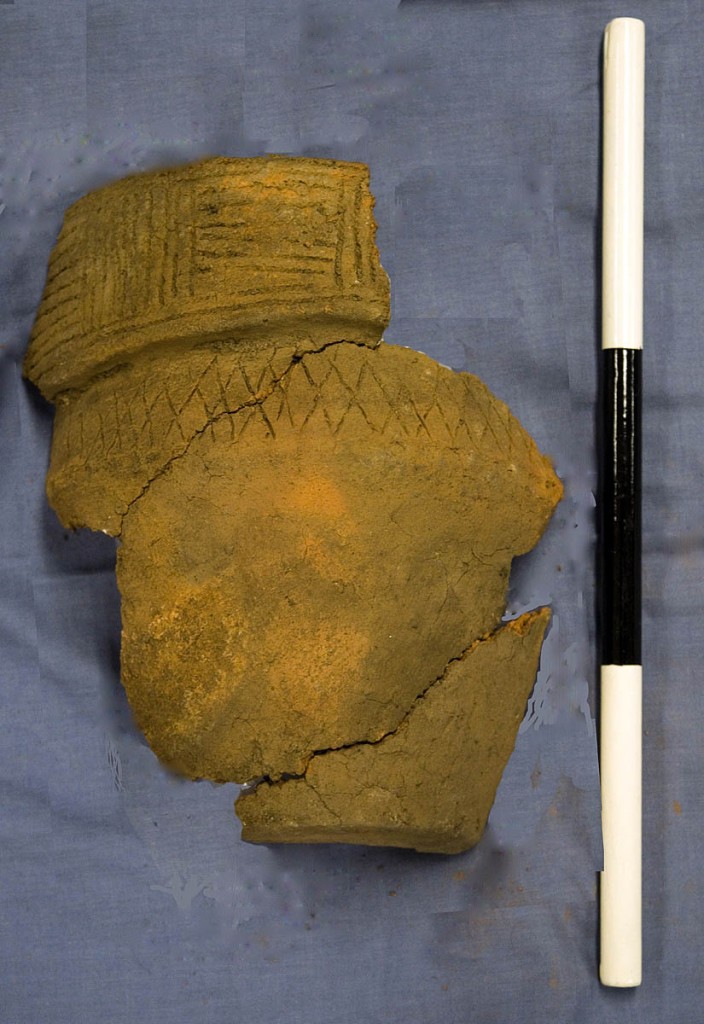A worker maintaining a footpath near a popular climbing crag discovered a Bronze Age pot containing human remains.
The cremation urn, believed to be about 3,500 years old, was found on The Roaches nature reserve in the Peak District.
Contractor Kieran Fogarty came across the earthenware artefact while digging a trench to reinforce a popular footpath at the site near Leek.
Ken Smith, cultural heritage manager for the Peak District national park, said: “Kieran did exactly the right thing; by contacting us so quickly we were able to get out to the site and identify what he had uncovered.
“From the type and style of the pot, and its contents, we identified it as a Bronze Age cremation urn and knew we needed to move quickly to conserve the remains.”
Mr Smith and cultural heritage team colleagues John Barnatt, Sarah Whiteley and volunteer Ann Hall carried out a rescue excavation to gain as much archaeological material and information from the site as possible.
Mr Smith said: “The impression of the urn’s side and base was still clearly visible in the edge of the cremation pit. We were also able to identify the edges of the pit that the urn had been placed in in prehistory. Within the fill of this pit was a significant amount of cremated bone and charcoal which we were able to recover fully.
“We are now looking for funding for post-excavation work so that specialists can study the urn and its contents. Close inspection of the pot fragments may tell us where the clay came from, whilst carbon-14 dating of the charcoal will help us put a date on the cremation.
“Study of the cremated bone will give an indication of the age, and even the sex, of the individual.”
Once the urn has been investigated it will be deposited with the Potteries Museum at Stoke.
Mr Smith added: “Often finds like this are associated with burial mounds but in this case there was no clue on the ground surface that there was archaeology present. It offers an important reminder that even small scale ground disturbance, such as footpath repair, can have an archaeological impact.
“The land at the Roaches is protected by law for its wildlife and landscape value, it is part of a site of special scientific interest, and the farmland is subject to a sensitive area agreement, so it is vital that we all play our part in looking after this special place.”
John Barnatt, who led the excavation, said: “The finding of the urn illustrates that people in the Bronze Age also probably appreciated and perhaps venerated this location.”
The 395ha (975-acre) estate in Staffordshire where the urn was found is owned by the Peak District National Park Authority and has been leased to the Staffordshire Wildlife Trust since 2013.
Helen Dale, head of people and property at Staffordshire Wildlife Trust, said: “This is a fascinating archaeological find. We’re happy to support the archaeological team of experts from the national park authority and will be following the investigation of the urn very closely.
“The Roaches is one of our most popular reserves with over 100,000 visits every year.
“We are continuing to carry out repair work to footpaths as part of our work to improve The Roaches – so any work which takes place there, either through volunteers or contractors – we’ll be informing them to be mindful of anything else they might come across in future.”
The estate is famed for its craggy skyline shaped by the rock formations of The Roaches and Hen Cloud are a much loved feature of the landscape and are visible for miles around. The moorland and climbing ridges are popular with walkers and climbers.
